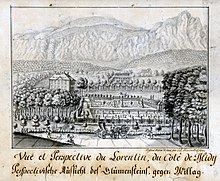Historisches Museum Blumenstein
The Historical Museum Blumenstein (HMBS) is the historical museum of the city of Solothurn that opened in 1952 in the baroque country estate of Blumenstein . Together with the Solothurn Art Museum and the Solothurn Nature Museum, it forms an administrative department for the municipality of Solothurn.
museum
The Blumenstein Historical Museum collects objects that represent relevant aspects of the history of the city of Solothurn and the communities directly adjacent to it. The residential exhibition on the ground floor gives an insight into the life of the Solothurn patriciate and the much less privileged everyday life of their employees. On the upper floor, a permanent exhibition and temporary exhibitions convey aspects of regional history. The representative rooms on the ground floor are used for public events, lectures and concerts and are open for private events.
history
The collection of the Historisches Museum Blumenstein was created in the 1860s with a view to building a museum for the city of Solothurn , which opened in 1902 as a classic multi-branch building. In addition to the historical and antiquarian collection, today's Solothurn Art Museum oversaw and brokered an art collection, a natural history and an ethnographic collection. The limited exhibition and storage space soon led to problems. When the Hirt-Baumgartner couple offered the city the former Blumenstein estate for sale in 1950, the city took the opportunity to move the historical and antiquarian collection to this property. The Blumenstein Historical Museum was opened on May 3, 1952. The current museum concept aims to provide a balanced range of permanent and temporary exhibitions, children's workshops, and public and private events.
Country seat (castle) Blumenstein
The former country estate of Blumenstein, which at the time of its greatest expansion in 1797 comprised 20 hectares, is now in the middle of a residential area. The extensive agricultural areas and the ornamental garden, which was laid out on seven terraces between 1699 and 1703, were completely built over in the 20th century. In the midst of the new buildings, the elaborate retaining walls of the former garden, the Fegetzallee built around 1700, two garden pavilions built in 1711 and the orangery from 1721, which was converted into a twin house in the 1920s, have been preserved. The farm building, built in 1726, burned down completely on August 1, 1952 and was demolished in 1954.
The ensemble of main building, courtyard, fountain house and garden vault was built by master builder Jean Fortier between 1725 and 1729 and a tenant house was added around 1800. Due to its compact construction, the main building clearly stands out from the type of tower house of older Solothurn country houses. The restrained facade contrasts with the very representative rooms inside. The refined interior design with mezzanine floors and a concealed staircase for the servants reflects the need for comfort of the France-oriented Solothurn patriciate that emerged in the era of the Régence .
history
Wolfgang I. Greder von Wartenfels (1592–1641), lieutenant and later regimental colonel in French service, bought an estate in 1624 in the area of the former stone quarry. The estate was already called Blumenstein back then. Wolfgang I and his son Wolfgang II (1632–1691) expanded the flower stoneware with land purchases in the following decades. In 1656 Greder had the existing house rebuilt. At that time, the vaulted cellar that still exists today was built in the basement of the main building. In 1691 the Blumenstein went to Franz Lorenz Greder (1658–1716). In 1698 he had the architect Melchior Erb work out a large-scale new building project and probably a more modest garden project afterwards. Greder had this second project carried out until 1703.
In 1709 Lorenz Greder von Wartenfels sold the flower stone to Franz Heinrich von Stäffis-Mollondin (1673–1749), who was married to Greder's sister Maria Franziska (1674–1743). Franz Heinrich came from an old Neuchâtel dynasty that took its name from Stäffis am See, Estavayer-le-Lac in French , and owned rich estates on both sides of Lake Neuchâtel . In the early 1720s, Franz Heinrich and Maria Franziska decided to build the Blumenstein summer house from scratch. In 1725 the house was torn down down to the vaulted cellar and the ensemble that still exists today was built by 1729.
After Franz Heinrich's death in 1749, the Blumenstein passed to his son Joseph Lorenz von Stäffis-Mollondin (1705–1758), who was married to Jeanne Charlotte Cléophe (1713–1794), born von Sury de Bussy. In 1757, son Johann Victor Urs Joseph Laurenz Fidel von Stäffis-Mollondin (1753–1787) and his wife Marie Jeanne Nicole (1757–1838), née Durfort-Léobard de Besançon, inherited the stoneware. With the death of Johann Victor in 1787 the line of those of Stäffis-Mollondin died out. The Blumenstein became a "Weibergut" that the two daughters Johanna Karolina Anophe and Ludovika Franziska shared with their grandmother Jeanne Charlotte Cléophe and their mother Marie Jeanne Nicole. It was only when Ludovika Franziska married Robert Fidel Carl Wallier von St. Aubin in 1797 that the Blumenstein became their sole property. After Ludovika Franziska's death, the Blumenstein passed to her sister-in-law Charlotte Glutz-Wallier von St. Aubin in 1847, who bequeathed the house to her three sons Edmund, Ludwig and Alfred Glutz-Ruchti in 1856. In 1861 Edmund bought out his three brothers and became the sole owner.
Edmund Glutz-Ruchti bequeathed the Blumenstein to his nephew Josef Glutz-Ruchti in 1885. This modernized the old summer residence fundamentally. In 1911 he expanded the house with a veranda, had a bathroom on the upper floor and a spacious kitchen and central heating in the basement. The former summer house, which previously could not be heated sufficiently with the existing chimneys, was now habitable all year round. Josef Glutz-Ruchti and his wife Mathilde, née Pfyffer von Heidegg, financed their lavish lifestyle by parceling out the extensive flower stoneware from 1919 and selling it piece by piece. Nevertheless, Glutz-Ruchti became insolvent in the mid-1920s; he went bankrupt and his property was auctioned. On October 18, 1928, the Basel architect HR Steuer bought the empty castle and the remaining garden for CHF 400,000. The garden was parceled out and sold as building land.
The tenant house and the farm building went to the tenant family Bläsi in 1933 for 16,000 francs, who ran the stoneware from 1870 to 1926 and from 1930. Fritz Hirt-Baumgartner bought the main building and its immediate surroundings on September 11, 1933 for 85,000 francs. In the following two decades, Fritz Hirt-Baumgartner and his wife Lucie set themselves the task of buying up various items from the former property of Josef and Mathilde Glutz-Ruchti and returning them to the Blumenstein.
Finally, on February 7, 1951, the Hirt-Baumgartner couple sold the Blumenstein for 180,000 francs and its inventory for 40,000 francs to the municipality of Solothurn, which opened its history museum in the Blumenstein on May 3, 1952. Fritz Hirt-Baumgartner's wife Lucie retained the right to live in some rooms on the upper floor until her death in 1977. After the fire in the farm building on August 1, 1952, the Bläsi family also sold the fire site and the adjoining tenant house to the city in 1955 for 80,000 francs.
literature
- Stefan Blank, Markus Hochstrasser: The city of Solothurn II, secular buildings. Die Kunstdenkmäler des Kanton Solothurn, Volume II. Society for Swiss Art History GSK, Bern 2008, pp. 396–409, ISBN 978-3-906131-88-7 .
- Erich Meyer: Jost Greder von Wartenfels 1553–1629. In: Yearbook for Solothurn History, Volume 47, Buchdruckerei Gassmann AG, Solothurn, 1974, pp. 219–263 doi: 10.5169 / seals-324533 .
- Museum concept - Historisches Museum Blumenstein . Approved by the museum commission of the municipality of Solothurn on March 25, 2010.
- Benno's mother: The Blumenstein country estate in Solothurn. (Swiss Art Guide, No. 905, Series 91). Ed. Society for Swiss Art History GSK. Bern 2012, ISBN 978-3-03797-062-1 .
- The Junker in the Bluemestei. In: Elisabeth Pfluger: Solothurn legends . Verlag Aare, 1988, pp. 147-148, ISBN 3-7260-0320-7 .
- Urs Scheidegger: It wasn't always like this ... - Leafed through the files of the city councilors of Solothurn. Volume II. Vogt-Schild Verlag, Solothurn 1986, pp. 140-142, ISBN 3-85962-083-5 .
Web links
Individual evidence
- ^ Museum concept 2010: p. 2.
- ↑ a b Museum Concept 2010: pp. 5–8.
- ^ Blank, Hochstrasser 2008: p. 401; Scheidegger 1986: p. 140.
- ↑ a b Blank, Hochstrasser 2008: pp. 397–398.
- ^ Blank, Hochstrasser 2008: pp. 398, 401.
- ↑ a b Blank, Hochstrasser 2008: pp. 398–399.
- ^ Blank, Hochstrasser 2008: pp. 407–408.
- ↑ Blank, Hochstrasser 2008: p. 396.
- ↑ a b Blank, Hochstrasser 2008: p. 400.
- ^ Blank, Hochstrasser 2008: p. 400; Scheidegger 1986: p. 140.
- ^ Scheidegger 1986: p. 140.
- ↑ a b c Blank, Hochstrasser 2008: p. 401.
- ^ Scheidegger 1986: p. 140.
- ^ Scheidegger 1986: p. 142.
Coordinates: 47 ° 12 '59.1 " N , 7 ° 32' 11.9" E ; CH1903: 607 424 / 229502



